

Secular supercessionism and alternative modernity. Recent years have seen the resurgence of “metahistories” that seek to provide a single complex narrative of seemingly disparate events and developments.
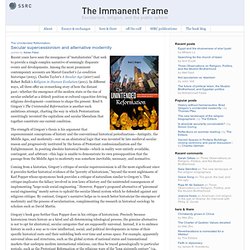
Among the most prominent contemporary accounts are Marcel Gauchet’s La condition historique (2005), Charles Taylor’s A Secular Age (2007) and Robert Bellah’s Religion in Human Evolution (2011). In different ways, all three offer an overarching story of how the distant past—whether the emergence of the modern state or the rise of secular unbelief as a default position or cultural capacities driving religious development—continues to shape the present. Brad S. Gregory’s The Unintended Reformation is another such ambitious attempt, charting the way in which Protestantism unwittingly invented the capitalism and secular liberalism that together constitute our current condition.
Gregory’s book goes further than Popper does in his critique of historicism. The Contrarian: Islamic Delights. Fundamentalism has become the face of Islam in the West.
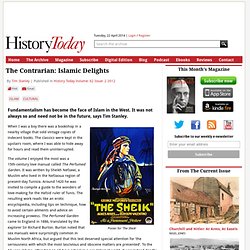
It was not always so and need not be in the future, says Tim Stanley. Poster for 'The Sheik'When I was a boy there was a bookshop in a nearby village that sold vintage copies of indecent books. The classics were kept in the upstairs room, where I was able to hide away for hours and read them uninterrupted. The volume I enjoyed the most was a 15th-century love manual called The Perfumed Garden. It was written by Sheikh Nefzawi, a Muslim who lived in the Nefzaoua region of present-day Tunisia. That such a book was able to find an audience in 19th-century England forces us to reassess Victorian attitudes towards both Islam and sexuality.
Arab Invasions: The First Islamic Empire. Islam's Origins: Where Mystery Meets History. Pinning Down Spartacus by Mary Beard. Spartacus by Aldo Schiavone, translated from the Italian by Jeremy Carden Harvard University Press, 177 pp., $19.95.

Perry Anderson · The Divisions of Cyprus · LRB 24 April 2008. How to do Empire Right? ELIZABETH THOMPSON BUTLER was one of the most celebrated painters of military life and scenes in the late 19th century imperial Britain.
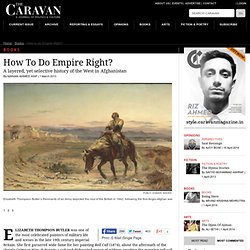
She first garnered wide fame for her painting Roll Call (1874), about the aftermath of the chaotic Crimean War. It depicts a sad and disheveled group of soldiers awaiting the morning roll call. It was a starkly un-romantic view of the troops, which sparked a wide-ranging debate on British military practices. Its significance as a cultural artifact was confirmed when Queen Victoria purchased the painting for her own collection. Shiekhupura and Shakespeare. For whom the bell tolls The 16th day of April 1853 is special in the Indian history.
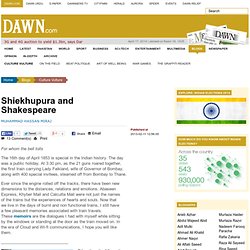
The day was a public holiday. At 3:30 pm, as the 21 guns roared together, the first train carrying Lady Falkland, wife of Governor of Bombay, along with 400 special invitees, steamed off from Bombay to Thane. Armenian monasteries in Iran. The excellent Días del futuro pasado blog gives news with images and drawings borrowed from the site of UNESCO about a group of monuments we especially love having recently been included on the list of World Heritage.
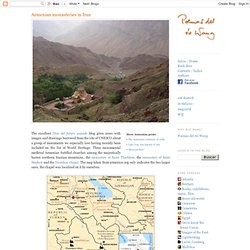
Three monumental medieval Armenian fortified churches among the majestically barren northern Iranian mountains, the monastery of Saint Thaddeus, the monastery of Saint Stephen and the Dzordzor chapel. The map taken from armenica.org only indicates the two larger ones, the chapel was localized on it by ourselves. All three sanctuaries lay in unpopulated valleys and have been abandoned since times immemorial. A monastery used to stand along the chapel as well, but it perished long ago. The environs are inhabited by Kurd and Azeri herdsmen and peasants. The American Muslim (TAM) Yarrow Mamout There have been a number of lists published (see bottom of this collection) over the years, but most were somewhat exclusive, focusing on particular segments of our American Muslim community.
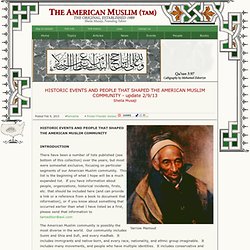
This list is the beginning of what I hope will be a much expanded list. If you have information about people, organizations, historical incidents, firsts, etc. that should be included here (and can provide a link or a reference from a book to document that information), or if you know about something that occurred earlier than what I have listed as a first, please send that information to tameditor@aol.com The American Muslim community is possibly the most diverse in the world. Our community includes Sunni and Shia and Sufi, and every madhab. There are events listed that had a negative impact on the American Muslim community, or that provided serious challenges. The commentary of Father Monserrate, S.J., on h... Geographic History Enjoys a Renaissance. The first history we write is a history of races.
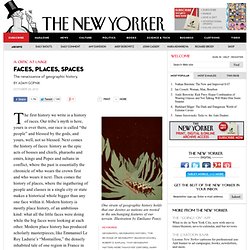
Our tribe’s myth is here, yours is over there, our race is called “the people” and blessed by the gods, and yours, well, not so blessed. The Baptism of Early Virginia: Interview with Rebecca Goetz, Part 2. Here is part two of our interview with Rebecca Goetz about her new book The Baptism of Early Virginia: How Christianity Created Race (Johns Hopkins University Press, 2012). 4) One of the older classics in this field is Winthrop Jordan's good long while, and was amazed to see how much he anticipated more contemporary discussions of issues such as "whiteness.
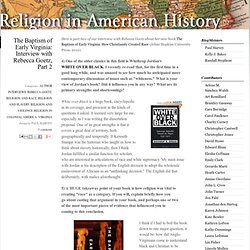
" What is your. Many Ways of Speaking about the Self: Middle Eastern Ego-documents in Arabic ... Perry Anderson · Why Partition? · LRB 19 July 2012. By 1945, the era of Gandhi was over, and that of Nehru had begun. It is conventional to dwell on the contrasts between the two, but the bearing of these on the outcome of the struggle for independence has remained by and large in the shadows. Nor are the contrasts themselves always well captured. Nehru was a generation younger; of handsome appearance; came from a much higher social class; had an elite education in the West; lacked religious beliefs; enjoyed many an affair. So much is well known. Perry Anderson reviews ‘Deng Xiaoping and the Transformation of China’ by Ezra Vogel, ‘On China’ by Henry Kissinger and ‘The Generalissimo’ by Jay Taylor · LRB 9 February 2012. Books about China, popular and scholarly, continue to pour off the presses.

In this ever expanding literature, there is a subdivision that could be entitled ‘Under Western Eyes’. The larger part of it consists of works that appear to be about China, or some figure or topic from China, but whose real frame of reference, determining the optic, is the United States. Typically written by functionaries of the state, co-opted or career, they have as their underlying question: ‘China – what’s in it for us?’ Rather than Sinology proper, they are Sino-Americana. Ezra Vogel’s biography of Deng Xiaoping is an instructive example. Running to some 850 pages, the book is, formally speaking, a mismatch at two levels. Perry Anderson reviews ‘When China Rules the World’ by Martin Jacques, ‘Capitalism with Chinese Characteristics’ by Yasheng Huang and ‘Against the Law’ by Ching Kwan Lee · LRB 28 January 2010.
These days Orientalism has a bad name. Edward Said depicted it as a deadly mixture of fantasy and hostility brewed in the West about societies and cultures of the East. He based his portrait on Anglo-French writing about the Near East, where Islam and Christendom battled with each other for centuries before the region fell to Western imperialism in modern times.
But the Far East was always another matter. Too far away to be a military or religious threat to Europe, it generated tales not of fear or loathing, but wonder. Marco Polo’s reports of China, now judged mostly hearsay, fixed fabulous images that lasted down to Columbus setting sail for the marvels of Cathay. What’s the big idea? David Armitage So-called big history has been inhospitable to the questions of meaning and intention so central to intellectual history – isn’t it time for a reconciliation? Published: 20 September 2012 I n many realms of historical writing, big is back. In some areas – historical archaeology, comparative sociology or world-systems theory – it never went away. In others, it clearly has disappeared, never to return: the globe-spanning universal histories associated with an Oswald Spengler or an Arnold Toynbee seem unlikely to be imitated again.
At its most ambitious, big history – so-called by its practitioners, who have now founded an International Big History Association – stretches back to the Big Bang itself. Perry Anderson · Kemalism: After the Ottomans · LRB 11 September 2008. ‘The greatest single truth to declare itself in the wake of 1989,’ J.G.A. Pocock wrote two years afterwards,